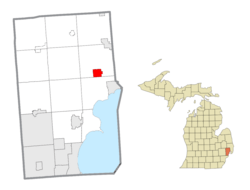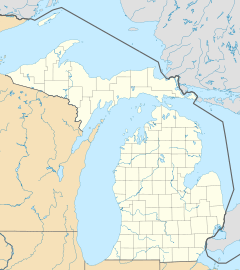New Haven, Michigan facts for kids
Quick facts for kids
New Haven, Michigan
|
|
|---|---|
|
Village
|
|
| Motto(s):
People Serving People
|
|

Location within Macomb County
|
|
| Country | United States |
| State | Michigan |
| County | Macomb |
| Township | Lenox |
| Incorporated | 1869 (village) |
| Government | |
| • Type | Village council |
| Area | |
| • Total | 2.53 sq mi (6.55 km2) |
| • Land | 2.53 sq mi (6.55 km2) |
| • Water | 0.00 sq mi (0.00 km2) |
| Elevation | 627 ft (191 m) |
| Population
(2020)
|
|
| • Total | 6,097 |
| • Density | 2,410.83/sq mi (930.92/km2) |
| Time zone | UTC-5 (Eastern (EST)) |
| • Summer (DST) | UTC-4 (EDT) |
| ZIP Code |
48048
|
| Area code(s) | 586 |
| FIPS code | 26-57380 |
| GNIS feature ID | 0633320 |
New Haven is a small village located in Macomb County, Michigan. It's part of Lenox Township. In 2020, about 6,097 people lived there. This was a big jump from 4,642 people in 2010.
Contents
History of New Haven
Early Settlers and Names
The first people to live in the New Haven area were Native Americans. They were mainly from the Ojibwa and Cherokee tribes. The Swan Creek Chippewa are a well-known part of this tribe. French settlers arrived in 1835. They bought the first land from the government.
The area was first called "New Baltimore Station." This was because of the Grand Trunk Western Railroad station there. This station mainly traded with the village of New Baltimore. New Baltimore is on Anchor Bay of Lake St. Clair.
Railroad and Roads
A special plank road connected New Haven to Romeo. This road was also known as the Ashley/Romeo Plank Road. The part of this road that went through the village became New Haven's main street. Today, this road changes names. It is Main Street in New Haven and Washington Street in New Baltimore.
The Grand Trunk Western railroad built the station in 1865. It moved goods like farm products and livestock by train. This happened all over the Midwest. The station building had living space for the station agent and their family. It had round windows in the Italianate style. This was similar to the Smiths Creek station now in Greenfield Village.
The New Haven station is still in its original spot. This is rare for stations in the Midwest. It has been fixed up and is now the village museum.
Village Growth and Services
New Haven got its first post office on January 6, 1838. Charles B. Matthews was the first postmaster. Adam Bennett helped organize the village a lot in its early days.
New Haven officially became a village on May 3, 1869. Benjamin L. Bates was chosen as the first village president. New Haven is the biggest village in Lenox Township, Macomb County.
By 1875, New Haven had many businesses. These included a general store, a sawmill, and an iron factory. There was also a creamery, hardware store, and a flour mill. Other businesses included farm supply stores, doctors, and places to fix carriages. There were also grocery stores, dry goods shops, and drug stores. You could find barrel makers, blacksmiths, and shoe stores. There were also harness shops, stove shops, wagon shops, and a hotel. The hotel was mostly known as the Graustark Hotel.
Modern Conveniences
In the early 1900s, New Haven got electricity. Frank Phelps owned the power house on Ann Street. He also owned one of the first cars in the village. His dynamo made enough electricity to light the whole village.
In the front of his building, he sold ice cream, candy, and oyster stew. He also showed silent movies on weekend nights. He used a big screen between two poles. He would play music on a phonograph with the movies.
New Haven built its own water system in 1945. The New Haven Public Library started in 1948.
Local News and Achievements
New Haven had several newspapers over the years. In 1895, there were The Advance and The Weekly Star. Later, there was The People's Advocate in 1912. From 1919 to 1924, it was The New Haven Star. In the 1940s, the New Haven Herald was published. It was later bought by the Anchor Bay Beacon. In 2017, New Haven High School won a state championship in basketball.
Geography
New Haven is in the eastern part of Macomb County. It is about 10 miles (16 km) northeast of Mount Clemens. Mount Clemens is the main city of the county. New Haven is also about 26 miles (42 km) southwest of Port Huron.
Highway M-19 goes through the east side of the village. This highway leads south to Interstate 94. It also goes northeast to Richmond.
The village of New Haven covers about 2.53 square miles (6.55 km²). Only a tiny part of this area is water. The Salt River flows through the east side of the village. It goes south to Lake St. Clair at Point Lakeview.
Population Data
| Historical population | |||
|---|---|---|---|
| Census | Pop. | %± | |
| 1870 | 413 | — | |
| 1880 | 600 | 45.3% | |
| 1890 | 606 | 1.0% | |
| 1900 | 489 | −19.3% | |
| 1910 | 478 | −2.2% | |
| 1920 | 535 | 11.9% | |
| 1930 | 774 | 44.7% | |
| 1940 | 904 | 16.8% | |
| 1950 | 1,082 | 19.7% | |
| 1960 | 1,198 | 10.7% | |
| 1970 | 1,855 | 54.8% | |
| 1980 | 1,871 | 0.9% | |
| 1990 | 2,331 | 24.6% | |
| 2000 | 3,071 | 31.7% | |
| 2010 | 4,642 | 51.2% | |
| 2020 | 6,097 | 31.3% | |
| U.S. Decennial Census | |||
2010 Census Information
In 2010, there were 4,642 people living in New Haven. There were 1,552 households and 1,160 families. The village had about 1,835 people per square mile (708 per km²). There were 1,695 homes, with about 670 homes per square mile (259 per km²).
Most people in the village were White (76.3%). About 16.9% were African American. A small number were Native American (0.5%) or Asian (0.5%). Some people were from other races (1.3%) or two or more races (4.5%). About 4.8% of the population was Hispanic or Latino.
In 49.4% of homes, there were children under 18. About 48.8% of homes had married couples. In 19.7% of homes, a female head of household lived without a husband. In 6.3% of homes, a male head of household lived without a wife. About 25.3% of homes were not families.
About 19.6% of all homes had only one person living there. About 4.7% had someone aged 65 or older living alone. The average household had 2.96 people. The average family had 3.40 people.
The average age in the village was 31.1 years old. About 33% of people were under 18. About 7.9% were between 18 and 24. About 32.4% were between 25 and 44. About 20.8% were between 45 and 64. And 6% were 65 years or older. The village had slightly more females (51.5%) than males (48.5%).
Notable People
- Romeo Weems, a professional basketball player
See also
 In Spanish: New Haven (Míchigan) para niños
In Spanish: New Haven (Míchigan) para niños



